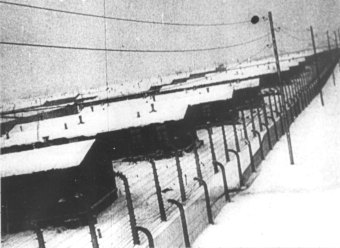Buna/Monowitz Concentration Camp

© Fritz Bauer Institute (APMO Collection / Auschwitz-Birkenau State Museum)
In late October 1942, I.G. Farben opened its own corporate concentration camp, Buna/Monowitz, to house the predominantly Jewish prisoners who had to do forced labor on the plant grounds of I.G. Auschwitz. The camp was built on the site of the Polish village of Monowice, whose inhabitants had been made to leave their homes. The first 2,100 prisoners arrived from the concentration camps of Buchenwald, Sachsenhausen, and Dachau, as well as from the Netherlands, in October and November 1942. In the next two years, the SS selected 10,000 men for forced labor in Buna/Monowitz from the pool of Jews deported to Auschwitz from every corner of Europe; their relatives, parents, wives, and children usually were murdered immediately after arrival in Auschwitz. Most prisoners in the Buna/Monowitz concentration camp, around 25,000 to 30,000, succumbed to the effects of the miserable rations, inadequate clothing, and harsh working conditions, were killed at the construction site, or fell victim to a selection and were sent to the gas chambers in Birkenau. In late 1944, more than 10,000 men were confined in Buna/Monowitz. As the Red Army approached Auschwitz in January 1945, the SS “evacuated” the Auschwitz camp complex, including the Buna/Monowitz concentration camp, on January 18 and forced the prisoners to take part in a death march. About 850 sick prisoners were abandoned in the Buna/Monowitz concentration camp; many died in the following days, and the survivors were liberated by the Red Army on January 27, 1945.
















